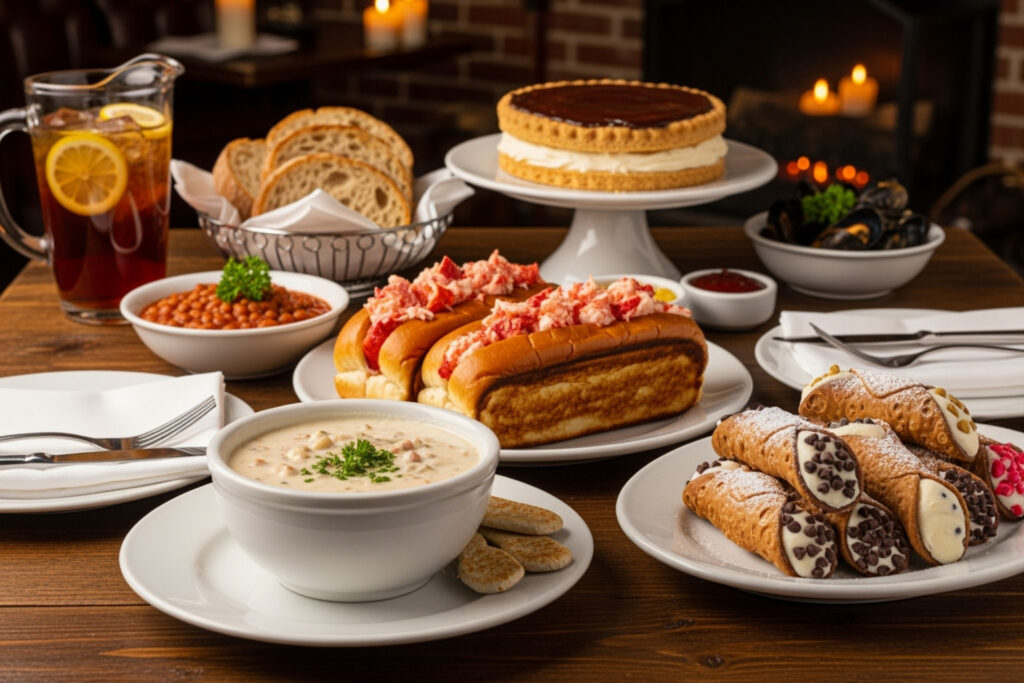Why Boston’s Culinary Legacy Defines New England
What food is Boston known for spans centuries of maritime tradition, immigrant influence, and Yankee ingenuity. From the creamy richness of New England clam chowder to the sweet indulgence of cannoli in the North End, Boston’s food scene tells the story of America itself.
Boston’s Most Famous Foods:
- New England Clam Chowder – The city’s signature cream-based soup
- Lobster Rolls – Fresh lobster on buttery split-top buns
- Boston Cream Pie – The official state dessert (it’s actually a cake!)
- Boston Baked Beans – The molasses-sweetened dish that earned the city its “Beantown” nickname
- Cannoli – Italian pastries from the historic North End
- Fenway Franks – Iconic ballpark hot dogs at America’s most beloved ballpark
Picture yourself wandering through Boston’s historic streets, where cobblestones pave the way past charming brownstones and legendary landmarks, and the salty harbor breeze blends with the scents of fresh seafood and sweet pastries. This is where culinary traditions were born from necessity, shaped by waves of immigrants, and perfected by generations of passionate cooks.
Boston’s coastal location has blessed the city with some of the freshest seafood in the country, while its role as a gateway for European immigrants created a unique fusion of flavors. The result? A food culture that’s both distinctly American and wonderfully diverse.
Whether you’re seeking the perfect bowl of “chowda” or exploring the ongoing cannoli wars between Mike’s Pastry and Modern Pastry, Boston offers food experiences that connect you to both history and community – values that align beautifully with a holistic approach to wellness and cultural appreciation.
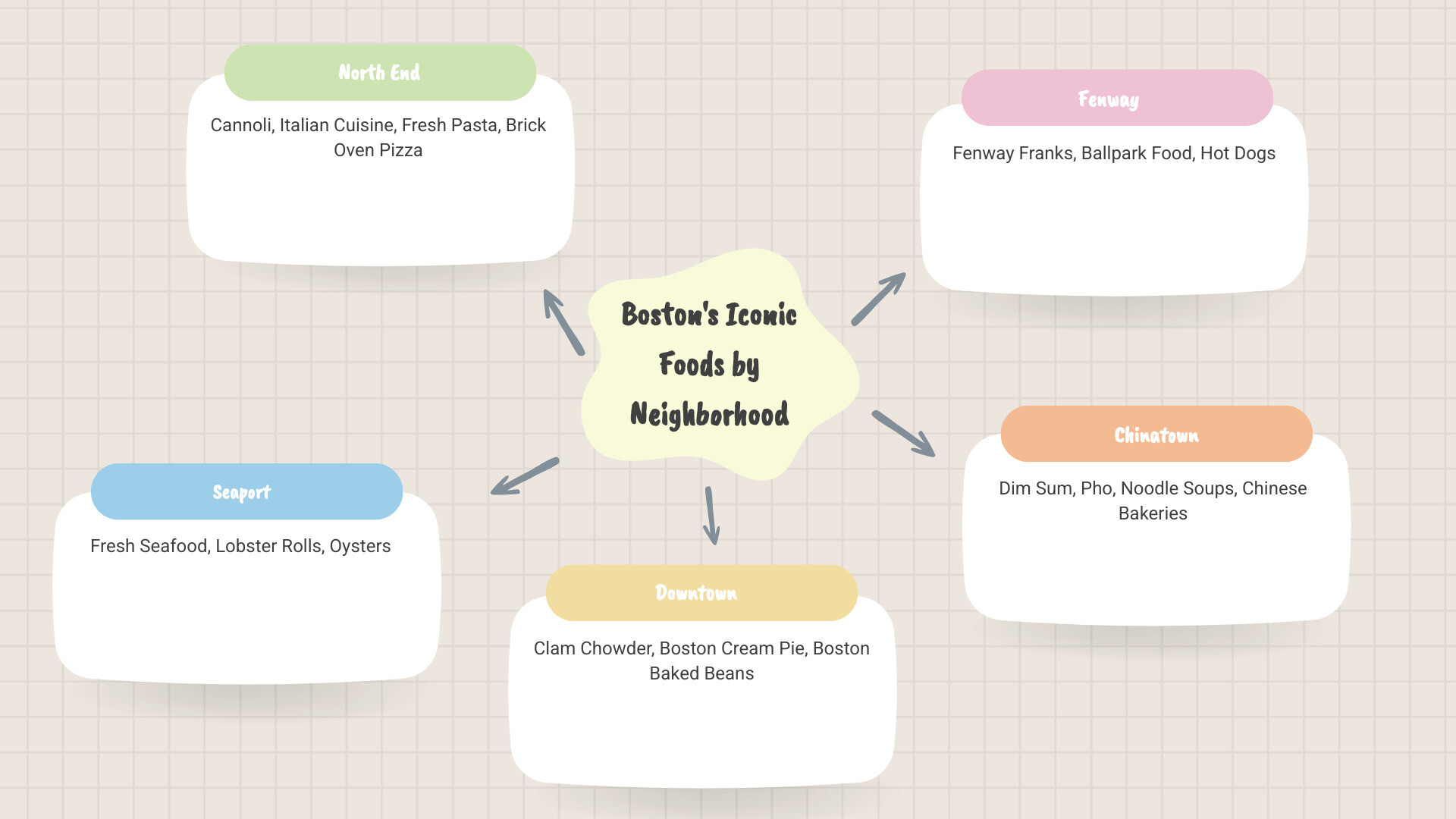
Related content about what food is boston known for:
#1: The Historic “Big Three” That Shaped Boston’s Palate
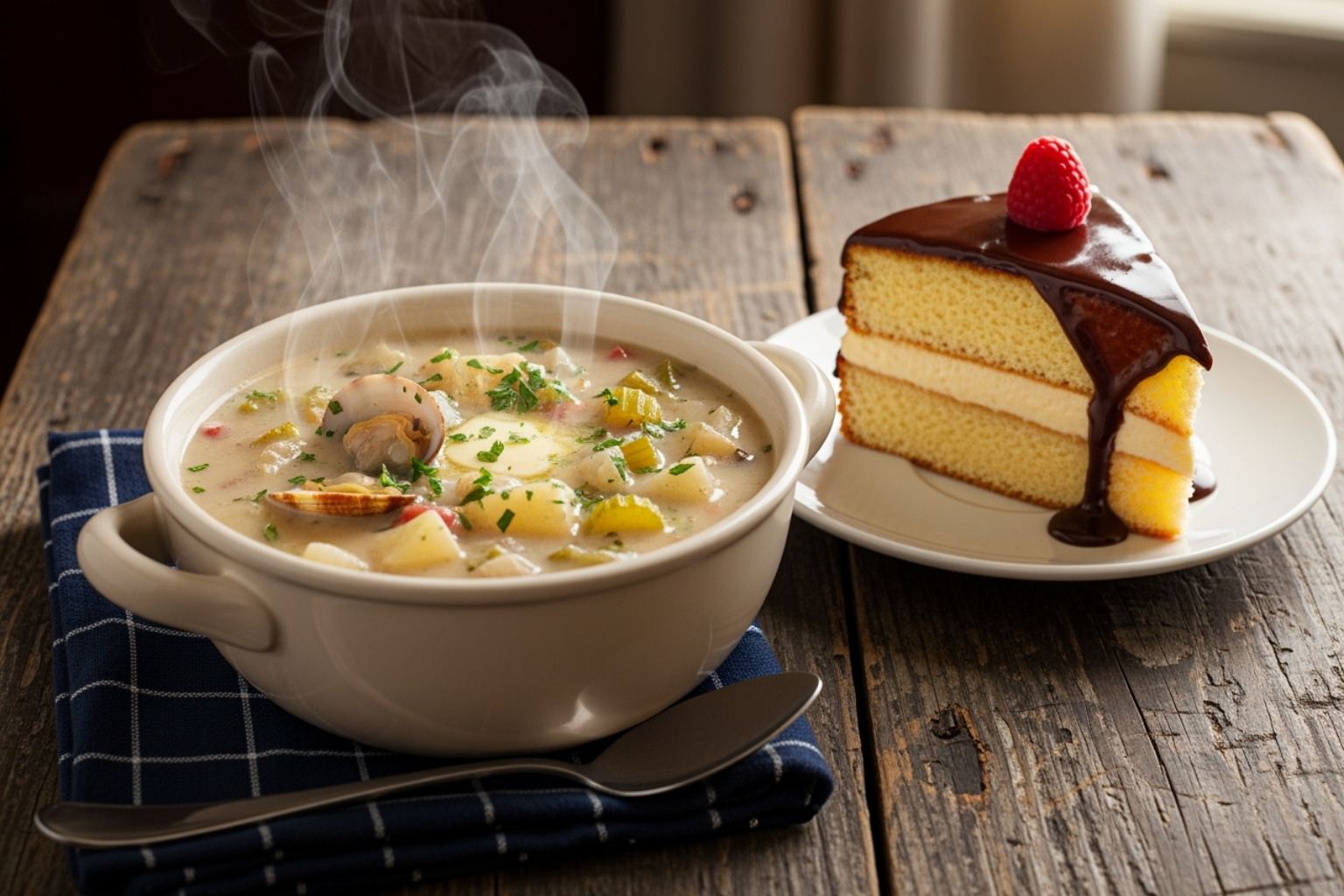
There’s something deeply satisfying about finding the culinary foundations of a city – it’s like uncovering the secret ingredients that make a place feel like home. When exploring what food is Boston known for, three historic dishes stand as the pillars of the city’s food identity: New England Clam Chowder, Boston Baked Beans, and Boston Cream Pie.
These aren’t just popular menu items – they’re edible history lessons that tell the story of Boston’s colonial roots, maritime heritage, and innovative spirit. Each dish emerged from practical needs and local ingredients, then evolved into beloved traditions that have nourished generations of Bostonians.
The Creamy “Chowda”
Walk into almost any Boston restaurant, and you’ll find New England Clam Chowder warming hearts and bellies. This isn’t just soup – it’s liquid comfort that captures the essence of New England’s coastal soul.
The magic happens in that signature cream-based broth, thick enough to coat your spoon and rich with the briny sweetness of fresh clams. Unlike the tomato-based Manhattan version (which many Bostonians consider heresy), New England chowder relies on milk or cream to create its distinctive ivory color and velvety texture. Tender chunks of potato, diced onions, and often bits of salt pork or bacon complete this maritime masterpiece.
The tradition dates back to the 1700s, when European immigrants brought their chowder-making skills to New England’s shores. They finded that local clams paired beautifully with familiar ingredients like potatoes and dairy, creating something entirely new yet comfortingly familiar.
For the most authentic experience, head to the Union Oyster House, America’s oldest continuously operating restaurant. Since 1826, they’ve been ladling out bowls of this iconic chowder, often served with a side of oyster crackers that you can crumble right into the creamy goodness.
“Beantown’s” Namesake Dish
Ever wonder why Boston earned the nickname “Beantown”? The answer lies in a humble pot of Boston Baked Beans, slow-cooked to perfection with molasses and salt pork.
This dish tells the story of Yankee ingenuity and colonial practicality. Families would start their beans cooking on Saturday, letting them simmer slowly overnight so they’d have a hot meal ready for Sunday – all while respecting Sabbath traditions that discouraged cooking. The result was a sweet and savory masterpiece that became the centerpiece of Saturday night suppers across New England.
What makes Boston’s version special is that distinctive sweetness from molasses, a key ingredient that reflects the city’s role in the triangular trade of the 18th century. The beans – typically small navy or pea beans – absorb all those rich flavors during their long, slow cook. Traditionally served alongside thick slices of brown bread, this hearty dish sustained hardworking families through long New England winters.
You can dive deeper into this fascinating culinary history with a deep dive into Boston Baked Beans, exploring how this simple dish became such an integral part of Boston’s identity.
The Official State Dessert
Here’s where Boston gets playfully confusing – the Boston Cream Pie is actually a cake! This beloved dessert earned such a special place in Massachusetts hearts that it became the official state dessert, and once you taste it, you’ll understand why.
Picture this: two layers of tender, fluffy sponge cake embracing a cloud of rich vanilla custard, all crowned with a glossy chocolate ganache that catches the light just so. It’s elegance and comfort rolled into one perfect slice.
The story begins in 1855 at the Parker House Hotel, where pastry chef Augustin Francois created this masterpiece. You can still experience the original Boston Cream Pie at the Omni Parker House Hotel, where they’ve been perfecting the recipe for over 150 years.
The cake vs. pie debate stems from the era when cakes and pies were often baked in similar pans, making the distinction a bit blurrier than today. What isn’t debatable is how this dessert perfectly balances sweetness with sophistication – the custard filling provides creamy richness while the chocolate topping adds just the right touch of decadence.
These three dishes form the foundation of Boston’s culinary character, each one reflecting the resourcefulness, tradition, and innovation that define this historic city. They remind us that the best foods often emerge from simple ingredients transformed by time, tradition, and a generous helping of local pride.
#2: The Unforgettable Taste of the Atlantic
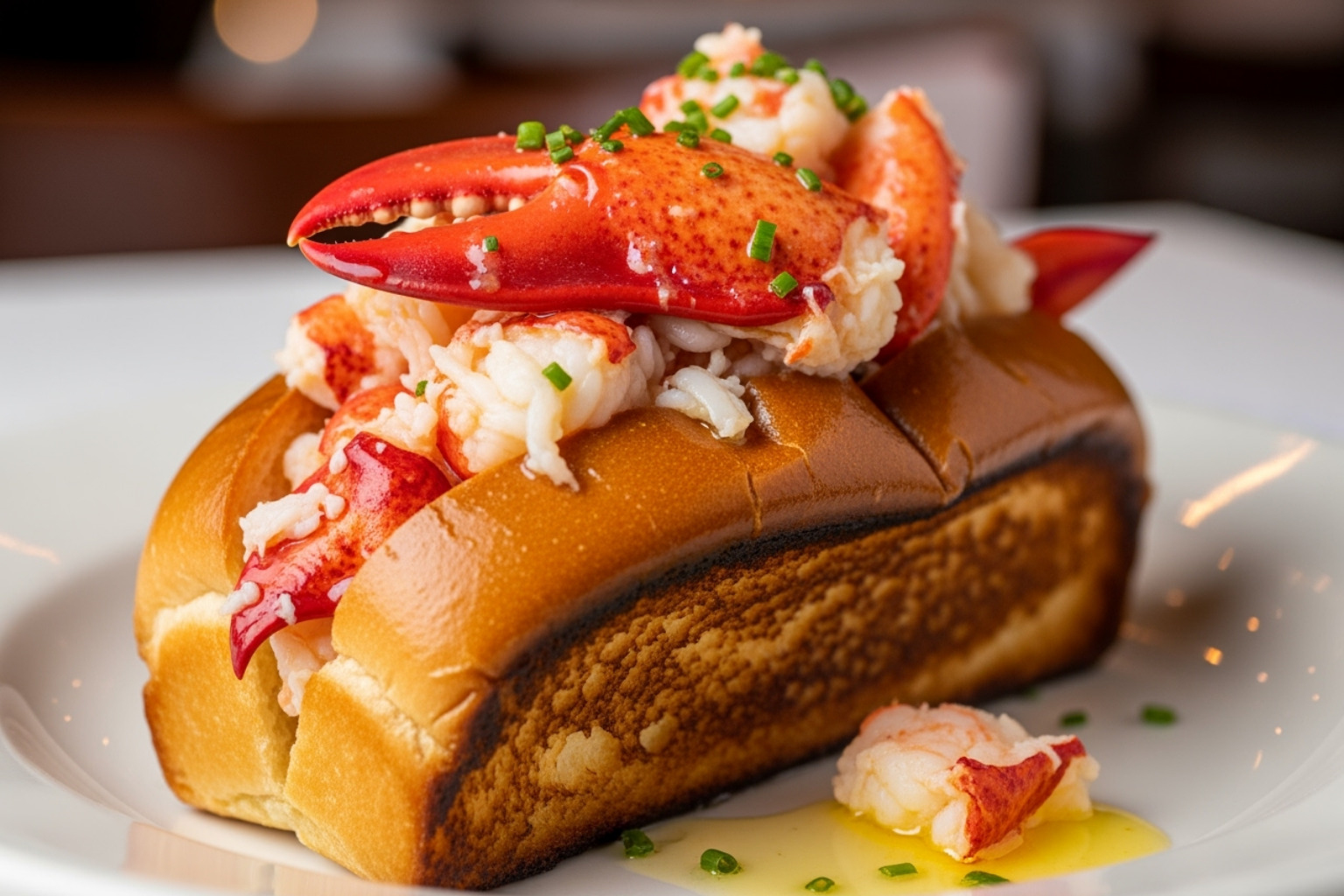
There’s something magical about Boston’s relationship with the sea. The city’s coastal location has blessed it with an endless supply of the freshest seafood you’ll find anywhere, and this ocean bounty plays a starring role in what food is Boston known for. From the moment you catch that first whiff of salt air mixed with the aroma of butter and garlic, you know you’re in for something special.
The Iconic Lobster Roll: Hot or Cold?
The great lobster roll debate is as heated as a summer day on the harbor. Walk into any seafood spot in Boston, and you’ll face a delicious dilemma: do you go with the hot buttered lobster roll or the cold mayonnaise-based version?
| Feature | Hot (Connecticut-style) Lobster Roll | Cold (Maine-style) Lobster Roll |
|---|---|---|
| Preparation | Lobster meat is gently warmed in melted butter, often with a hint of lemon. | Lobster meat is chilled and tossed with mayonnaise, sometimes with celery or chives. |
| Flavor Profile | Rich, buttery, and savory, allowing the natural sweetness of the lobster to shine. | Creamy, tangy, and refreshing, with the mayonnaise adding a smooth texture and subtle flavor. |
| Texture | Warm, tender, and succulent. | Cool, firm, and crisp (if celery is included). |
| Bun | Typically served on a toasted, buttered, split-top hot dog bun, a New England specialty. | Also served on a toasted, buttered, split-top hot dog bun. |
The hot version lets the sweet lobster meat shine through that rich, melted butter, while the cold roll offers a refreshing contrast with its creamy mayo dressing. Both are served on those iconic toasted split-top buns that are practically a New England trademark.
For the real deal, head to James Hook and Co., a family-run spot that’s been serving up perfection since 1925. They know their lobster, and it shows in every single bite. Expect to pay anywhere from 16 to 35 dollars for this indulgence, but trust us – it’s worth every penny.
Beyond the Roll: Oysters, Clams, and More
While lobster rolls get all the Instagram love, Boston’s seafood scene runs much deeper. The city’s raw bars are legendary, serving up Wellfleet oysters that taste like the ocean itself – briny, fresh, and absolutely divine. These plump beauties come from some of the cleanest waters around, and you can taste the difference.
Then there are the steamers – soft-shell clams that arrive at your table in a steaming bowl, begging to be dipped in drawn butter and clam broth. It’s messy eating at its finest, and somehow that makes it even better.
But here’s where things get really interesting: Boston is home to the birthplace of the fried clam. Woodman’s of Essex has been frying up these golden nuggets since 1914, and their technique is still best. These aren’t your average clam strips – we’re talking about whole belly clams, crispy on the outside and tender on the inside.
Don’t overlook scrod either – this mild, flaky fish (usually young cod or haddock) is a local favorite that’s often broiled with breadcrumbs until golden. It’s comfort food that happens to be incredibly fresh and delicious.
Understanding what food is boston known for: The Seafood Staples
Boston’s maritime heritage isn’t just history – it’s a living, breathing part of the city’s identity. During summer months, the city comes alive with seafood festivals where locals and visitors gather to celebrate the Atlantic’s bounty. The emphasis here is always on freshness and quality, reflecting a deep respect for what the ocean provides.
Seasonal availability keeps menus exciting and ensures you’re always getting the best catch. Spring brings tender scallops, summer means peak lobster season, and fall delivers the sweetest oysters. This rhythm with the sea is part of what makes Boston’s seafood scene so authentic and special.
Whether you’re slurping oysters at a raw bar, cracking into a perfectly steamed lobster, or savoring a bowl of creamy fish and chips, you’re experiencing centuries of tradition. This connection to the sea nourishes not just the body but the spirit – something that aligns beautifully with a holistic approach to wellness and appreciating life’s simple pleasures.
#3: What Food is Boston Known For? A Tale of Immigrant Kitchens
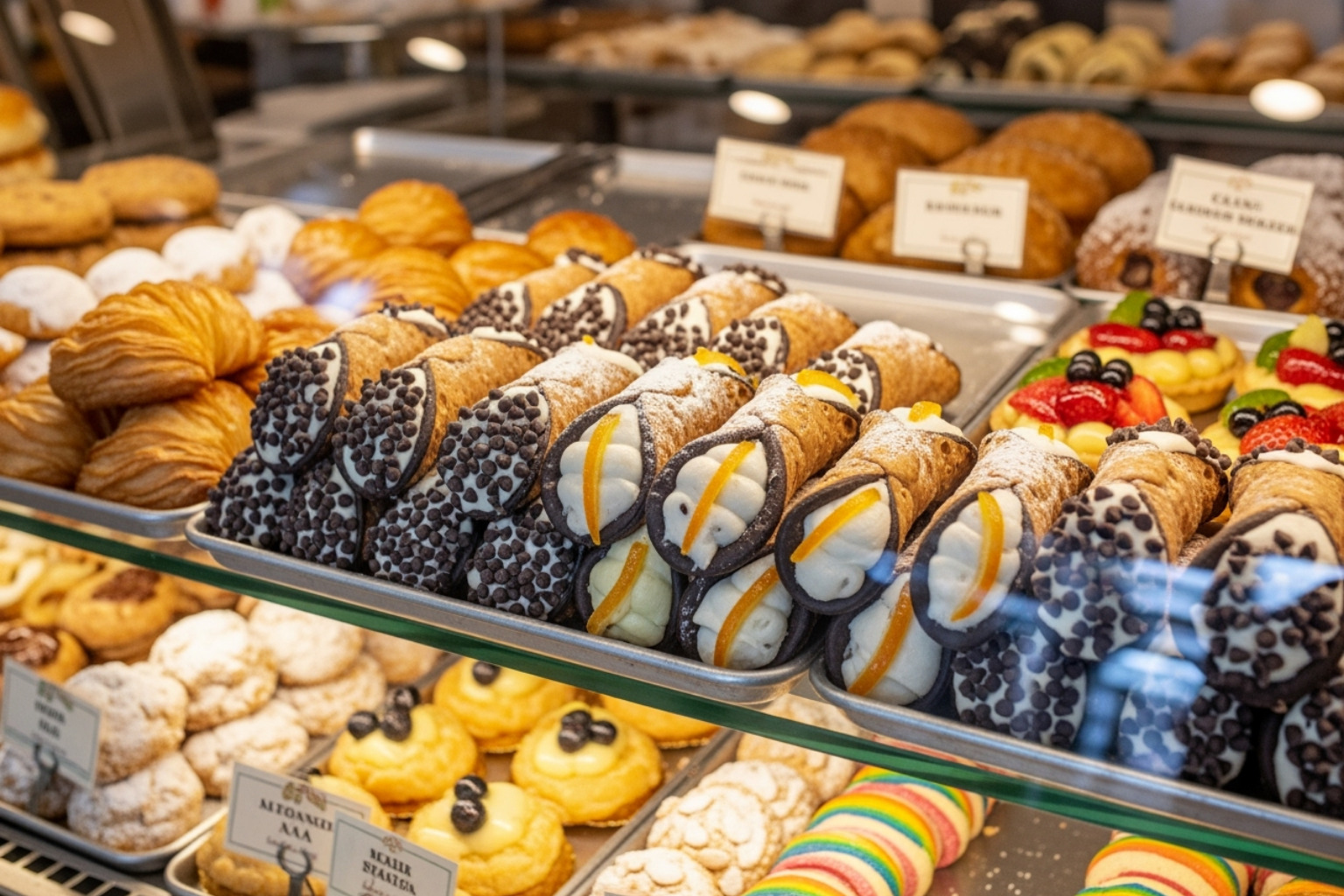
Boston’s true culinary magic happens when you explore beyond its famous seafood and historic dishes. The city’s neighborhoods tell stories through food – stories of families who crossed oceans with cherished recipes tucked in their hearts. These immigrant communities didn’t just adapt to Boston; they transformed it, creating a cultural melting pot where what food is Boston known for extends far beyond clam chowder and baked beans.
Walking through Boston today, you’ll find that each neighborhood has its own culinary identity. The North End whispers “Buongiorno” with the scent of fresh basil and garlic. Southie echoes with Irish warmth and hearty comfort food. Chinatown bustles with the sizzle of woks and steaming dim sum baskets. These aren’t tourist attractions – they’re living, breathing communities where food connects generations.
The North End: A Slice of Italy
Step into the North End, and you’ll swear you’ve been transported to a charming Italian village. Narrow cobblestone streets wind past red-brick buildings where Italian-American food has flourished for over a century. This isn’t just about restaurants – it’s about tradition passed down through families who’ve called this neighborhood home for generations.
The heart of any North End visit? The legendary cannoli wars between Mike’s Pastry and Modern Pastry. Both bakeries have devoted followers who’ll passionately defend their choice. Mike’s draws crowds with its colorful array of flavored fillings, while Modern Pastry wins hearts with its more traditional, delicately sweet ricotta. Honestly, the real winner is you – because trying both is practically a Boston rite of passage.
But the North End’s magic extends beyond pastries. Fresh pasta made daily fills the windows of small shops, while the aroma of garlic and oregano drifts from family-run trattorias. Regina Pizzeria has been serving brick oven pizza since 1926, and their original Thatcher Street location still uses the same coal-fired ovens that made them famous. The thin, crispy crust and perfectly charred edges create a pizza experience that’s uniquely Boston.
Irish Influence in Southie and Beyond
Boston’s Irish heritage runs deep, especially in South Boston, where traditional pubs serve as community gathering places just as they did in the old country. The food here tells stories of resilience and comfort – dishes designed to warm both body and soul during New England’s harsh winters.
Corned beef and cabbage might be the most famous Irish-American dish, but Boston’s pubs offer so much more. Shepherd’s Pie arrives at your table bubbling hot, with savory meat and vegetables crowned by a golden layer of mashed potatoes. Hearty stews simmer slowly, filling the air with rich, comforting aromas that make you want to settle in for the evening.
The beauty of Boston’s Irish food scene lies in its authenticity. These aren’t fancy interpretations – they’re the same recipes that sustained Irish families through generations. An Irish breakfast on a Sunday morning, complete with black pudding and soda bread, connects you to a tradition that spans continents.
The Vibrant Flavors of Chinatown
Boston’s Chinatown pulses with energy and authenticity that’s hard to find elsewhere in New England. As the region’s only Chinatown, this compact neighborhood packs incredible diversity into just a few busy blocks. The experience here goes beyond just eating – it’s about finding flavors that might be completely new to you.
Dim Sum transforms weekend mornings into festive occasions. Servers wheel carts filled with steamer baskets through crowded restaurants, and half the fun is pointing to dishes you’ve never seen before. Delicate har gow (shrimp dumplings) burst with flavor, while fluffy char siu bao (barbecue pork buns) offer sweet and savory comfort.
Beyond Chinese cuisine, you’ll find incredible pho and noodle soups that warm you from the inside out. Chinese bakeries display mysterious and delightful treats – sweet egg tarts, flaky pastries, and breads that blend Eastern and Western influences. The authentic regional dishes here represent not just China, but Vietnam, Thailand, and other Asian countries, making Chinatown a true celebration of Asian culinary traditions.
What makes exploring these immigrant kitchens so rewarding is how they reflect Boston’s welcoming spirit. Just like wellness practices that nourish both body and soul, these food traditions create connections between cultures and generations, showing us that the best meals are about so much more than just eating.
#4: Quintessential Boston Bites and Sips
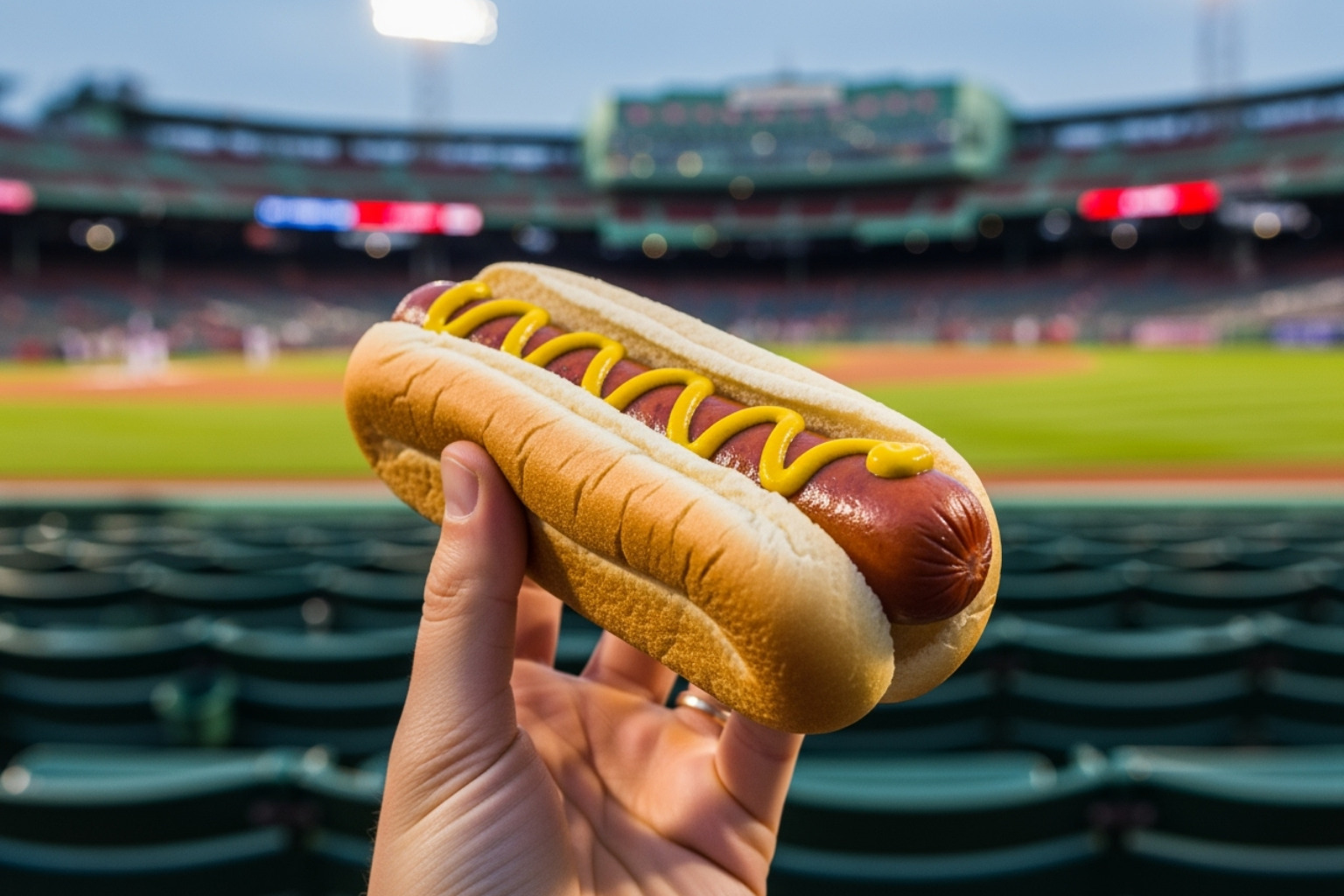
Some of the most beloved what food is Boston known for experiences aren’t found in fancy restaurants or historic establishments. Instead, they’re woven into the fabric of everyday Boston life – from the crack of a bat at Fenway Park to ordering the “wrong” drink at an ice cream shop. These quintessential bites and sips capture something special about Boston’s character: its sports passion, regional quirks, and that distinctly New England way of doing things.
The Fenway Frank and North Shore Roast Beef
There’s something magical about biting into a Fenway Frank while the crowd roars around you at America’s most beloved ballpark. This isn’t just any hot dog – it’s a Boston tradition that connects you to generations of Red Sox fans who’ve cheered, groaned, and celebrated in those same green seats.
The Fenway Frank gets its signature taste from being boiled first, then grilled to perfection. It’s served on a split-top New England bun (sliced across the top rather than the side) and traditionally topped with yellow mustard. The experience goes beyond the food itself – it’s about being part of Fenway Park’s incredible atmosphere, where every bite tastes better when paired with the crack of the bat and the energy of 37,000 passionate fans.
But Boston’s ballpark culture extends beyond hot dogs. Just north of the city, you’ll find another regional obsession that locals guard fiercely: the North Shore Roast Beef Sandwich. This isn’t your typical deli sandwich – it’s a towering creation of thinly sliced, rare roast beef piled high on a soft onion roll.
The magic happens with the “three-way” preparation: American cheese, tangy barbecue sauce, and creamy mayonnaise all working together to complement the tender beef. Kelly’s Roast Beef in Revere has been perfecting this art since 1951, and one bite explains why this sandwich has inspired such devoted local following. It’s hearty, satisfying, and uniquely Boston – the kind of comfort food that becomes a craving once you’ve experienced it.
Frappes, Not Milkshakes
Here’s where visiting Boston becomes a delightful lesson in regional vocabulary. Walk into any ice cream shop and ask for a milkshake, and you might get a puzzled look. In Boston, what you’re really looking for is a frappe (pronounced “frap”).
The difference matters more than you might think. A milkshake in New England is simply milk blended with flavored syrup. But a frappe is the thick, creamy, ice-cream-based drink that most of the country calls a milkshake. Boston’s frappes are famously thick and rich – often so thick you need a spoon as much as a straw.
For the ultimate frappe experience, Toscanini’s in nearby Cambridge has earned legendary status for their creative flavors and commitment to quality. Whether you choose classic vanilla or venture into more adventurous territory, you’ll understand why Bostonians are so particular about their frozen treats.
The city’s local breweries add another layer to Boston’s drinking culture. From the iconic Samuel Adams to innovative craft breweries like Harpoon, Boston’s brewing heritage runs as deep as its tea-dumping history. These local brews pair perfectly with the city’s comfort foods and offer another authentic taste of Boston life.
These everyday pleasures remind us that what food is Boston known for isn’t just about historic dishes or immigrant traditions. It’s also about the simple joy of finding how a city’s personality shows up in its most casual moments – whether you’re cheering at Fenway or learning the proper way to order ice cream.
Frequently Asked Questions about Boston’s Famous Foods
We’ve journeyed through many delicious parts of what food is Boston known for, but let’s wrap up by answering some common questions to help solidify your culinary adventure in this historic city.
What is the single most famous food in Boston?
Ah, the million-dollar question! It’s truly tough to pick just one, as Boston’s food identity is a rich mix woven from many threads. However, if we absolutely had to choose, the top contenders would certainly be New England Clam Chowder, the iconic Lobster Roll, and the sweet Boston Cream Pie.
Each of these dishes holds immense cultural significance and is instantly recognizable as a taste of Boston. The creamy clam chowder deeply symbolizes the city’s maritime past. The lobster roll represents its incredible coastal bounty. And the Boston Cream Pie showcases its innovative culinary history. Many locals might argue for the comforting “chowda” as the ultimate symbol, given its deep historical roots and widespread popularity through the centuries.
What dessert is Boston famous for?
When it comes to sweet treats, Boston truly shines with two standout desserts. The first is, of course, the Boston Cream Pie. This delightful creation, famously invented at the Omni Parker House Hotel, even holds the title of Massachusetts’ official state dessert! It’s a unique and delicious blend of fluffy cake, rich vanilla custard, and a generous layer of chocolate ganache.
The second, equally famous, are the cannoli. These crisp, cream-filled pastries arrived with Italian immigrants and are now incredibly popular, especially in the historic North End. The friendly “cannoli wars” between Mike’s Pastry and Modern Pastry add to their allure, making a visit to both a delicious rite of passage. Both the Boston Cream Pie and cannoli offer distinct, unforgettable sweet experiences that are deeply embedded in the city’s vibrant food culture.
Where can I find the most authentic Boston food experience?
To truly dive into the authentic tastes of Boston, we highly recommend exploring specific neighborhoods and seeking out some of its most historic eateries.
For a taste of Italy, the North End is simply unparalleled. Here, you’ll find incredible Italian-American cuisine, from fresh pasta to the famous cannoli we just discussed. For vibrant Asian flavors, a trip to Chinatown is a must, especially for dim sum and other regional specialties.
For traditional New England fare, step back in time at historic establishments like the Union Oyster House (America’s oldest continuously operating restaurant), where you can savor classic clam chowder and briny oysters. And don’t forget to explore Boston’s food markets, such as the Boston Public Market. These spots offer locally sourced ingredients and artisanal products that truly reflect the region’s agricultural bounty. Engaging with these places allows you to not only taste Boston’s history but also experience its evolving, diverse culinary scene, connecting food with cultural exploration and well-being.
Conclusion
What an incredible journey we’ve had through Boston’s vibrant culinary landscape! It’s truly clear that what food is Boston known for is a delicious mix woven from its deep history, diverse cultural influences, and the incredible bounty of the Atlantic. From the comforting, historic flavors of New England clam chowder and the molasses-sweetness of Boston baked beans, to the fresh ocean delights of lobster rolls and oysters, and the sweet temptations of Boston Cream Pie and North End cannoli, every dish tells a unique and mouthwatering story.
Boston’s food scene isn’t just about what’s on your plate; it’s a living, breathing expression of the city’s identity, its strong sense of community, and generations of cherished traditions. Exploring these iconic foods offers a wonderful way to truly connect with Boston’s heart and understand its fascinating past. For us at Beyond Beauty Lab, we believe that appreciating these kinds of rich cultural experiences – and yes, that absolutely includes the pure joy of food! – is a key part of a holistic approach to wellness. Just as clean beauty nourishes your body, cultural exploration like a culinary adventure enriches your mind and spirit. That’s the essence of the Beyond Beauty Lab philosophy.
So, the next time you find yourself in this historic and wonderfully delicious city, we wholeheartedly encourage you to start on your very own culinary adventure. Savor each bite, explore every charming neighborhood, and find the incredible flavors that make Boston a true gastronomic treasure.
Ready to continue your journey of enriching experiences? Explore more wellness and cultural guides with us.

